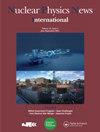In Memoriam: Peter Schuck (1940–2022)
Q4 Physics and Astronomy
引用次数: 0
Abstract
Professor Dr. Peter Schuck, one of the leading specialists in many-body physics in nuclear and other fundamental systems, passed away on 10 September 2022, at the age of 82. He began his education at the Technical University of Munich in a group headed by Wilhelm Brenig, introducing Green’s function techniques into the description of manybody systems. Following his Ph.D., as a postdoc at Massachusetts Institute of Technology in Boston, he worked with Felix Villars on collective vibrations and their coupling to singleparticle motion. He went to France, first to the Institut Laue Langevin and later to the IPN in Grenoble. In 1980, he joined the IPN in Orsay, where he became directeur de research at the CNRS. During his years in Grenoble, he collaborated with Peter Ring on the celebrated book The Nuclear Many-Body Problem (1980), which is still one of the most important textbooks on nuclear theory, particularly concerning many-body techniques applied to finite self-bound Fermi systems. Generations of young researchers have used this book for their work. Today it is also well known in physical chemistry and mesoscopic condensed matter physics. Schuck also worked on ideas to describe strongly interacting finite Fermi systems as a system of interacting bosons; that is, on a microscopic interpretation of the phenomenological Interacting Boson Model of Arima and Iachello that was, and is still, used worldwide with great success for the description of nuclear spectra. He also studied collective phenomena as, for example, various forms of scissor modes in deformed protonand neutron-distributions (isospin-scissors) or spin orientations (spin-scissors) that oscillate against each other. Together with groups in Barcelona, Catania, and Madrid, he developed in Paris a very successful new energy density functional (BCPM) for the universal description of nuclear systems. Schuck also worked on intermediate energy nuclear physics and was the first to predict a strong in-medium dependence of the spectral intensity of the so-called sigma meson. In addition, he developed the theory of quantum condensates and pairing. He also made important contributions to the physics of cold atoms and other problems in condensed matter. Over the years, he developed an interest in various extensions of the random phase approximation and the equationof-motion method. Since 2000, Schuck became well known in relation to the theory of alpha particle condensation in nuclear systems (e.g., quartetting in the Hoyle state). Since this theory was first proposed in 2001, in a highly cited article in Physical Review Letters, it has provoked a strong increase in interest internationally, both theoretically and experimentally, and initiated a number of conferences and several reviews. Schuck enjoyed various international collaborations, particularly within Europe and with colleagues from India, Japan, and China. He was editor of European Physical Journal A and was one of the most respected theoreticians from the European Physical Society (EPS). In 2004, he was the recipient of the Gay-LussacHumboldt prize. In 2018, together with Peter Ring, he received the Lise Meitner Prize for nuclear physics from the EPS. With the passing of Peter Schuck, we not only lose a foremost expert in the field of nuclear theory and manybody physics, who inspired many new ideas, initiated discussions, and collaborations. Above all, we have lost a friend and congenial colleague who was always helpful and receptive to new problems. We will remember him with great fondness and miss him in future work.纪念:彼得·舒克(1940-2022)
Peter Schuck博士教授于2022年9月10日逝世,享年82岁,他是核和其他基本系统多体物理学的主要专家之一。他在慕尼黑工业大学开始了他的教育,在一个由Wilhelm Brenig领导的小组中,他将格林的函数技术引入到多体系统的描述中。在获得博士学位后,他在波士顿的麻省理工学院做博士后,与菲利克斯·维拉斯一起研究集体振动及其与单粒子运动的耦合。他去了法国,先是去了朗格万研究所,后来去了格勒诺布尔的IPN。1980年,他加入奥赛的IPN,成为法国国家科学研究中心的研究主任。在格勒诺布尔的几年里,他与彼得·林合作出版了著名的《核多体问题》(1980年),这本书仍然是核理论最重要的教科书之一,特别是关于应用于有限自束缚费米系统的多体技术。一代又一代的年轻研究人员在他们的工作中使用这本书。今天,它在物理化学和介观凝聚态物理中也很有名。舒克还研究了将强相互作用有限费米系统描述为相互作用玻色子系统的想法;也就是说,对Arima和Iachello的现象相互作用玻色子模型的微观解释,这个模型在过去和现在仍然在世界范围内成功地用于描述核光谱。他还研究了集体现象,例如,在变形的质子和中子分布(同位旋-剪刀)或自旋方向(自旋-剪刀)中相互振荡的各种形式的剪刀模式。与巴塞罗那、卡塔尼亚和马德里的团队一起,他在巴黎开发了一个非常成功的用于核系统通用描述的新能量密度泛函(BCPM)。舒克还研究了中能核物理学,他是第一个预测所谓的西格玛介子的光谱强度在介质中有很强的依赖性的人。此外,他还发展了量子凝聚和配对理论。他还对冷原子物理学和其他凝聚态物质问题做出了重要贡献。多年来,他对随机相位近似和运动方程方法的各种扩展产生了兴趣。自2000年以来,Schuck在核系统中的α粒子凝聚理论(例如,霍伊尔态的四重奏)方面变得广为人知。自从这一理论于2001年在《物理评论快报》(Physical Review Letters)上一篇被高度引用的文章中首次提出以来,它在理论上和实验上都引起了国际上兴趣的强烈增长,并引发了一些会议和几篇评论。Schuck喜欢各种国际合作,特别是在欧洲以及与来自印度、日本和中国的同事合作。他是欧洲物理杂志A的编辑,是欧洲物理学会(EPS)最受尊敬的理论家之一。2004年,他获得了盖伊-吕萨洪堡奖。2018年,他与彼得·林一起获得了EPS颁发的莉斯·迈特纳核物理奖。随着Peter Schuck的去世,我们不仅失去了一位在核理论和多体物理领域最重要的专家,他激发了许多新的想法,发起了讨论和合作。最重要的是,我们失去了一位总是乐于助人、乐于接受新问题的朋友和志同道合的同事。我们将在今后的工作中怀念他,怀念他。
本文章由计算机程序翻译,如有差异,请以英文原文为准。
求助全文
约1分钟内获得全文
求助全文
来源期刊

Nuclear Physics News
Physics and Astronomy-Nuclear and High Energy Physics
CiteScore
0.80
自引率
0.00%
发文量
39
 求助内容:
求助内容: 应助结果提醒方式:
应助结果提醒方式:


